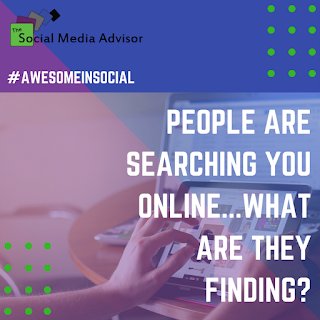#AwesomeInSocial – People Are Searching You Online…What Are They Finding?
When was the last time you searched for you or your company online? Most consumers will start their search online before ever using your company. Reviews, social media interaction, comments left on product pages, website ease of use, and more are key factors in determining whether a new customer or client will do business with you.
When you consider that online reviews are the key to people’s trust in your business, the choice is clear. You have to know what people are saying about you. A recent survey by BrightLocal states that 84% of people will trust an online review the same as word-of-mouth.
This means it’s more important than ever for you to take control of your social platforms. You want those conversations to happen with you and your social channels. That’s not all. Knowing how they find you can help you identify new opportunities to reach customers on platforms that you’re either not using or have underdeveloped. In some cases, it can even help your company evolve to meet the changes of your customer base.
I’ve compiled a list of ways to find out how you’re being searched.
Use Multiple Search Engines
If you want to know how people find you, the best way to begin is by using Google or Bing to see how you measure up. A key point here is to use your browser’s private browsing feature so that your previous searches don’t affect the results. Google uses “Incognito” and Firefox has “Private Browsing” but they both work the same.
Do a search for your business name and see what the first page results are. You’ll likely find your website/blog, Facebook page, review sites like Yelp, online listing platforms like Google My Business, and other social networks.
After that search is complete, you’ll want to try search terms that could drive people to your business. Start with your website. Most website analytics will track the search terms that get people to your site. Compile that list and start searching. Where do you stand in first page ranking?
Next, you’ll want to do a local search for your business using key terms related to your work. This one is easy. Take your most popular key terms and add your town to the end of the search. A repair shop, for instance, would search for “car shop in [town name]”. If you offer particular services, make sure you use those terms as well. Where do you stand?
With this list, you can determine where your business is showing up and note the places where it should be listed, but isn’t.
Social Media
Make sure you use Twitter and Facebook’s search options to see what people are saying about your business. Search your business name first. What do you find? If your business has a more common name, you can add keywords to the list. This is a search you should often perform, since it helps you stay on top of customer complaints and celebrate business successes.
Also, your online presence will play a big factor in the impression you make to anyone searching for your business. What are they finding? Are the accounts current – or have they not been updated in ages? If you have social media accounts active, showing a lack of current content makes the audience believe you are no longer investing in your business. It’s better to not have an account at all then to have one that hasn’t been updated in ages.
If you have been posting recently, does that content coincide with your branding strategy and goals for the current year? Or is it random and confusing for your audience – sharing content that appeals to you but isn’t strategic can be damaging and counterproductive.
Also, your online presence will play a big factor in the impression you make to anyone searching for your business. What are they finding? Are the accounts current – or have they not been updated in ages? If you have social media accounts active, showing a lack of current content makes the audience believe you are no longer investing in your business. It’s better to not have an account at all then to have one that hasn’t been updated in ages.
If you have been posting recently, does that content coincide with your branding strategy and goals for the current year? Or is it random and confusing for your audience – sharing content that appeals to you but isn’t strategic can be damaging and counterproductive.
Set Up Analytics
You can use Google Alerts to search the web for keywords related to your business. Those results will be sent to your inbox as often as you wish. Social media platforms like Facebook now offer analytics, and you’ll want to keep track of those. Google My Business offers insights for your business listings. As mentioned earlier, you can also set up your website analytics to find out how people are tracking you. The tools are available, so make sure you use them.
Once you figure how they find you, the next step is to make it easier to connect with your business. The key to success is to keep on top of this. Your online reputation and being #AwesomeInSocial work hand in hand in convincing potential clients to contact you and set up a discovery session.
Be sure to Follow us and Let’s Engage!
Hollie Clere of The Social Media Advisor is a “#BeAwesome” Developer, Social Media, Brand Builder, Content Manager, Trainer and Author in LinkedIn, Facebook, Twitter, Blog, Google+, YouTube, Pinterest, Instagram and the tools to manage them.
Click here for her Social Media Workshops, Classes, and Seminars






